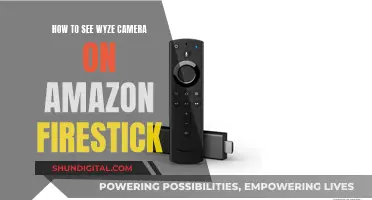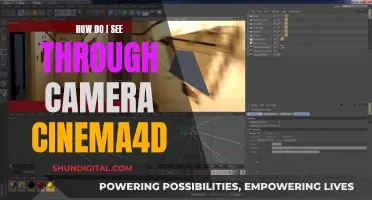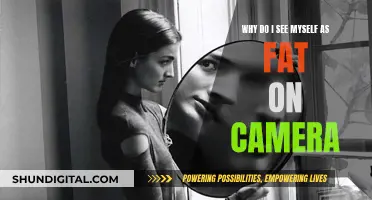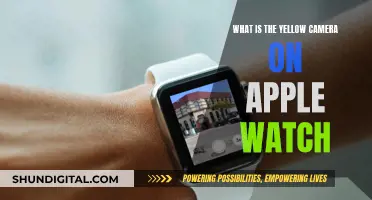
Seeing yourself on camera can be a difficult task for many people. Whether it's for a video interview, filming yourself, or just wanting to see what you look like, there are several ways to see yourself on camera. This can be done by using a simple online mirror application or by connecting your camera to a computer monitor.
| Characteristics | Values |
|---|---|
| Use an online mirror | Use an application like howtotechies mirror to see yourself on a computer screen or mobile |
| Use a monitor | Use a computer monitor or an external monitor to see yourself while filming |
| Use your phone | Use the front and back camera on your phone; the rear camera is better quality |
| Use a laptop as a viewfinder | Use apps to screencast your phone to your laptop |
| Use mobile apps | Use mobile apps to take video or photos of yourself |
What You'll Learn

Use an online mirror
Using an online mirror is a great way to see yourself on camera without needing an actual mirror. This can be especially useful if you want to check your appearance on the go, such as when you're in a meeting, a classroom, or out shopping. There are many websites and applications that offer this service, and they generally work in a similar way.
To use an online mirror, you will need to give the website or application access to your camera. When you first load the page or app, you'll usually see a pop-up window asking you to "allow" or "deny" camera access. Simply click "allow" to activate the online mirror. This will allow the tool to display the feed from your webcam or mobile camera in your browser. Remember that your image is first converted to data before being projected back to you, which is different from a regular mirror, where light is simply reflected.
Some online mirrors offer additional features, such as the ability to capture images, apply beauty filters, or change the image style by adjusting the brightness, contrast, or colour settings. You may also be able to zoom in and out, giving you a closer look at specific details. These extra features can be particularly handy if you're using the online mirror to try on new makeup or glasses, as you can see how different options look with the added benefit of filters and adjustments.
It's important to note that while these tools can be convenient, they may not always provide the best image quality, especially in low-light conditions. This is because cameras typically struggle to focus and produce clear images in such environments, resulting in a fuzzy or noisy picture. However, with adequate lighting, an online mirror can be a quick and easy way to check your appearance whenever you need to.
Lane Watch Camera: A Safety Feature for Drivers
You may want to see also

Check your camera is working
There are several ways to check if your camera is working. Firstly, you can try using an online webcam test site. These sites will ask for permission to access your camera and then display the feed from your webcam. This is a good way to check if your camera is working without having to install any additional software. Some popular webcam test sites include Webcamtests.com, Webcammictest.com, and OnlineMicTest.com.
If you would prefer not to use an online test site, you can test your camera using built-in applications on your device. If you are using a Windows 10 device, you can test your camera by typing "Camera" into the search box on the Windows taskbar. This will open the Camera app, which will display the feed from your webcam. Alternatively, you can find the Camera app in the Windows Start Menu. If you are using a MacOS device, you can test your camera by opening the Photo Booth app, which is located in the Applications folder. For Ubuntu Linux users, there is a free photo booth app called Cheese that can be used to test your webcam.
If you are using an external webcam, you can also try plugging it into a different USB port on your device to see if that resolves any issues. Additionally, make sure that your camera is selected in the software you are using, as sometimes issues can arise if the software is looking for another device that is disconnected or disabled.
Accessing HCVR Camera Footage on Your PC
You may want to see also

Use your phone's rear camera
Using your phone's rear camera to take a selfie can be a great way to get a high-quality photo. Here are some tips to help you make the most of your phone's rear camera:
Trial and Error
The easiest way to take a picture with the rear camera is to use trial and error. Position yourself in front of the camera and take a picture, then check the result and adjust your pose or the position of the device accordingly. It might take a few tries, but you'll eventually get it right. Make sure you give the app enough time to use the auto-focus feature, and consider setting a timer to give yourself time to pose and let the camera focus. You don't have to hold the phone in your hand; you can prop it up on an object or use a selfie stick.
Third-Party Apps
You can use third-party camera apps like Candy Cam to make taking selfies with the rear camera easier. These apps often include features like timers, filters, and touch shot, which allows you to snap a photo by tapping anywhere on the screen. Some apps, like Back Camera Selfie-Voice Guide, can even guide you via voice instructions, telling you which way to move the camera or when to smile. These apps can also provide a preview of the picture and options to share or print it.
Fingerprint Scanner
If you have a phone like a OnePlus, you can use the fingerprint scanner to snap photos. This feature can be turned on in your phone's settings by selecting "Buttons & gestures" and then enabling "Long press to take a photo". With this enabled, you can simply long-press the fingerprint sensor to take a picture.
Volume Buttons
Alternatively, you can use your phone's volume keys to take pictures. On a Pixel phone, for example, you can enable this feature by going into Settings, searching for "Camera", selecting "Gestures", and then choosing "Volume key action" and "Shutter". With this set up, you can long-press one of the volume buttons to take a picture easily.
Google Assistant
You can also use Google Assistant to take a hands-free selfie with the rear camera. Simply say, "Hey Google, take a photo", and it will count you down so you can pose. Make sure you have the phone positioned with the rear camera pointing at you before giving the command.
Finding and Using Your Windows 7 Camera
You may want to see also

Connect your camera to a monitor
To connect your camera to a monitor, you will need to ensure you have the correct cables to connect the two devices. The specific cables required will depend on the type of camera and monitor you are using. For example, if you are using a DSLR camera, you may need an HDMI or SDI cable to connect to an HD monitor. Once you have the correct cables, follow these steps:
- Power off both the camera and the monitor before making any connections to avoid damaging the equipment.
- Connect the cable to the camera's output port, typically located on the side or back of the camera body.
- Route the cable to the monitor, ensuring there is enough slack to avoid putting strain on the ports.
- Connect the other end of the cable to the input port on the monitor. Again, the input port location will vary depending on the monitor model.
- Power on both devices and set the correct input on the monitor to display the camera feed. You may need to adjust settings on the camera or monitor to get the desired image.
If you are using a modern camera and monitor, you may be able to connect wirelessly. In this case, ensure both devices are connected to the same Wi-Fi network and follow any specific instructions provided by the manufacturers to establish the wireless connection.
Additionally, if you are using a webcam, the process may be even simpler. You can follow these steps:
- Connect the webcam to your computer, either by plugging it into a USB port or using a built-in camera on your device.
- Open the software or application you wish to use with the camera. This could be a video conferencing app, a photo or video editing software, or a simple camera app.
- Within the software, select the option to switch on or enable the camera. This may be a button or an option in a settings menu.
- Adjust any settings or preferences within the software to customise the image to your liking.
The Ultimate Camera-Top Tally Box: Marshall Electronics V-LCD-TV
You may want to see also

Overcome cognitive biases
There are several ways to see yourself on camera. You could use an online mirror, which displays the feed from your webcam or mobile camera to your browser. Alternatively, you could use a video conferencing app or a video recording app. However, if you are using a Lenovo computer, you may need to refer to specific instructions for this type of device.
Now, when it comes to overcoming cognitive biases related to seeing yourself on camera, here are some detailed instructions:
Understand Cognitive Biases
Firstly, it's important to recognize that cognitive biases are a natural part of human cognition. They are mental shortcuts that help our brains process information quickly. However, they can sometimes lead to inaccurate judgments and irrational behaviour. Understanding what cognitive biases are and how they work is the first step to overcoming them.
Recognize Your Own Biases
Cognitive biases can be challenging to spot, especially in ourselves. Pay attention to signs such as only paying attention to information that confirms your opinions, attributing others' success to luck while taking personal credit for your accomplishments, blaming external factors for your failures, and assuming that everyone shares your beliefs. If you notice these patterns in your thinking, you may be influenced by cognitive biases.
Challenge Your Biases
Once you've identified your biases, actively challenge them. Seek out information that contradicts your existing beliefs. Practice intellectual humility by acknowledging that your beliefs may not be absolute truth. Consider alternative explanations and be open to changing your mind.
Reframe Your Perspective
Try to see yourself on camera from a different perspective. Instead of focusing on your perceived faults, remind yourself that any negative bias you perceive is unique to you and not how others see you. Your brain may be tricking you into seeing faults that aren't there or that others don't notice. Refocus your attention on delivering value to your audience rather than worrying about how you look.
Seek Feedback
Ask for feedback from others and be open to receiving it. Remember that others do not share your biases about yourself, and their opinions may help you overcome your negative self-image. However, be cautious about whom you seek feedback from, as some people may unintentionally reinforce your negative biases.
Practice Self-Compassion
Lastly, be kind to yourself. Recognize that it's normal to feel nervous or uncomfortable on camera. Challenging your cognitive biases takes time and effort, and it's okay to not be perfect. Treat yourself with compassion and acknowledge your efforts to improve.
Watching Pi Camera Footage: A Guide for Your Pi Desktop
You may want to see also
Frequently asked questions
You can use an online mirror application, which displays the feed from your webcam or mobile camera to your browser. Alternatively, if you are using a camera to record yourself, you can connect it to a computer monitor or your laptop to view yourself in real-time.
If you are filming yourself, it is recommended to use a monitor to control the composition, focus, and exposition. You can use your laptop as a viewfinder by connecting it to your phone or camera. Additionally, make sure to only use one application at a time that accesses your camera.
There are two psychological concepts that contribute to your desire to avoid the camera: the Familiarity Principle and Confirmation Bias. The Familiarity Principle states that we prefer to see mirror images of ourselves because that is how we normally see ourselves, and the image in the mirror is slightly different from how others see us. Confirmation Bias refers to how our brains tirelessly look for information that confirms our preconceived notions about ourselves, and we tend to focus on negative traits.
The best way to get used to seeing yourself on video is to acknowledge and confront these cognitive biases. Start by recording short, 5-10 minute segments and gradually increase the duration. Watch these recordings a few times a week for a couple of weeks before sharing them with a trusted colleague or coach.







